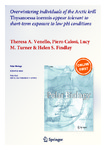Overwintering individuals of the Arctic krill Thysanoessa inermis appear tolerant to short-term exposure to low pH conditions
| dc.contributor.author | Venello, TA | |
| dc.contributor.author | Calosi, P | |
| dc.contributor.author | Turner, Lucy | |
| dc.contributor.author | Findlay, HS | |
| dc.date.accessioned | 2017-10-27T09:13:53Z | |
| dc.date.issued | 2017-08-04 | |
| dc.identifier.issn | 0722-4060 | |
| dc.identifier.issn | 1432-2056 | |
| dc.identifier.uri | http://hdl.handle.net/10026.1/10102 | |
| dc.description.abstract |
Areas of the Arctic Ocean are already experiencing seasonal variation in low pH/elevated pCO2 and are predicted to be the most affected by future ocean acidification (OA). Krill play a fundamental ecological role within Arctic ecosystems, serving as a vital link in the transfer of energy from phytoplankton to higher trophic levels. However, little is known of the chemical habitat occupied by Arctic invertebrate species, and of their responses to changes in seawater pH. Therefore, understanding krill’s responses to low pH conditions has important implications for the prediction of how Arctic marine communities may respond to future ocean change. Here, we present natural seawater carbonate chemistry conditions found in the late polar winter (April) in Kongsfjord, Svalbard (79°North) as well as the response of the Arctic krill, Thysanoessa inermis, exposed to a range of low pH conditions. Standard metabolic rate (measured as oxygen consumption) and energy metabolism markers (incl. adenosine triphosphate (ATP) and l-lactate) of T. inermis were examined. We show that after a 7 days experiment with T. inermis, no significant effects of low pH on MO2, ATP and l-lactate were observed. Additionally, we report carbonate chemistry from within Kongsfjord, which showed that the more stratified inner fjord had lower total alkalinity, higher dissolved inorganic carbon, pCO2 and lower pH than the well-mixed outer fjord. Consequently, our results suggest that overwintering individuals of T. inermis may possess sufficient ability to tolerate short-term low pH conditions due to their migratory behaviour, which exposes T. inermis to the naturally varying carbonate chemistry observed within Kongsfjord, potentially allowing T. inermis to tolerate future OA scenarios. | |
| dc.format.extent | 341-352 | |
| dc.language | en | |
| dc.language.iso | en | |
| dc.publisher | Springer Science and Business Media LLC | |
| dc.subject | Euphausiacea | |
| dc.subject | Arctic Ocean | |
| dc.subject | Kongsfjord | |
| dc.subject | Ocean acidification | |
| dc.subject | Ocean change | |
| dc.subject | Crustaceans | |
| dc.title | Overwintering individuals of the Arctic krill Thysanoessa inermis appear tolerant to short-term exposure to low pH conditions | |
| dc.type | journal-article | |
| dc.type | Journal Article | |
| plymouth.author-url | https://www.webofscience.com/api/gateway?GWVersion=2&SrcApp=PARTNER_APP&SrcAuth=LinksAMR&KeyUT=WOS:000424276400012&DestLinkType=FullRecord&DestApp=ALL_WOS&UsrCustomerID=11bb513d99f797142bcfeffcc58ea008 | |
| plymouth.issue | 2 | |
| plymouth.volume | 41 | |
| plymouth.publication-status | Published online | |
| plymouth.journal | Polar Biology | |
| dc.identifier.doi | 10.1007/s00300-017-2194-0 | |
| plymouth.organisational-group | /Plymouth | |
| plymouth.organisational-group | /Plymouth/Faculty of Science and Engineering | |
| plymouth.organisational-group | /Plymouth/Faculty of Science and Engineering/School of Biological and Marine Sciences | |
| plymouth.organisational-group | /Plymouth/REF 2021 Researchers by UoA | |
| plymouth.organisational-group | /Plymouth/REF 2021 Researchers by UoA/UoA07 Earth Systems and Environmental Sciences | |
| plymouth.organisational-group | /Plymouth/Users by role | |
| plymouth.organisational-group | /Plymouth/Users by role/Academics | |
| dcterms.dateAccepted | 2017-07-28 | |
| dc.rights.embargodate | 2018-8-4 | |
| dc.identifier.eissn | 1432-2056 | |
| dc.rights.embargoperiod | Not known | |
| rioxxterms.versionofrecord | 10.1007/s00300-017-2194-0 | |
| rioxxterms.licenseref.uri | http://www.rioxx.net/licenses/all-rights-reserved | |
| rioxxterms.licenseref.startdate | 2017-08-04 | |
| rioxxterms.type | Journal Article/Review |


